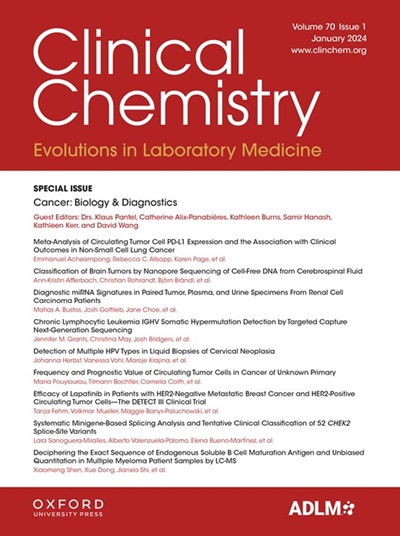Enrichment of Microbial DNA in Plasma to Improve Pathogen Detection in Sepsis: A Pilot Study
IF 7.1
2区 医学
Q1 MEDICAL LABORATORY TECHNOLOGY
引用次数: 0
Abstract
Background Diagnosis of sepsis and timely identification of pathogens in critically ill patients remains challenging. Plasma metagenomic sequencing to detect microbial cell-free DNA (mDNA) has shown promise, but low abundance of mDNA in plasma limits sensitivity and necessitates high sequencing depth. mDNA is shorter and more fragmented than human cell-free DNA. Here, we evaluated whether combining single-stranded DNA (ssDNA) sequencing library preparation and size selection can enrich mDNA and improve pathogen detection. Methods We prospectively enrolled 48 trauma patients and collected daily blood samples during the first 10 days of intensive care unit (ICU) admission. For patients with culture-proven infections, we extracted plasma DNA, prepared double-stranded DNA (dsDNA) and ssDNA sequencing libraries, and applied size selection to exclude fragments >110 bp. Following sequencing, we performed taxonomic classification, and evaluated differences in mDNA fractions and in sensitivity for pathogen detection (compared to background noise). Results We analyzed 46 plasma samples from 5 patients who developed culture-proven infections, including 17 samples coincident with positive microbial cultures. Size-selected ssDNA libraries showed the total mDNA fraction 204-fold higher on average than conventional dsDNA libraries (P < 0.0001). However, for pathogen-specific DNA (at the genus level), the highest sensitivity was observed in size-selected dsDNA (82%), compared to dsDNA (41%), ssDNA (71%), and size-selected ssDNA (35%) library preparations. Conclusions Our results demonstrate that combining ssDNA library preparation together with fragment size selection improves mDNA yield, potentially reducing sequencing requirements. However, at the genus level, this combination also increases background noise, which limits sensitivity for pathogen detection.血浆中微生物DNA的富集提高败血症病原体检测的初步研究
背景对危重患者进行脓毒症的诊断和病原体的及时鉴定仍然具有挑战性。血浆宏基因组测序检测微生物无细胞DNA (mDNA)已显示出前景,但血浆中低丰度的mDNA限制了灵敏度,并且需要高测序深度。mDNA比人类无细胞DNA更短,更碎片化。在这里,我们评估了结合单链DNA (ssDNA)测序文库制备和大小选择是否可以丰富mDNA并提高病原体的检测。方法前瞻性纳入48例创伤患者,在重症监护病房(ICU)入院前10天每日采集血液样本。对于经培养证实的感染患者,我们提取血浆DNA,制备双链DNA (dsDNA)和ssDNA测序文库,并应用大小选择排除&;gt;110 bp的片段。测序后,我们进行了分类分类,并评估了mDNA组分的差异和病原体检测的敏感性(与背景噪声相比)。结果我们分析了5例经培养证实的感染患者的46份血浆样本,其中17份样本微生物培养呈阳性。大小选择的ssDNA文库显示,总mDNA分数平均比传统的dsDNA文库高204倍(P <;0.0001)。然而,对于病原体特异性DNA(在属水平上),与dsDNA(41%)、ssDNA(71%)和大小选择的ssDNA(35%)文库制剂相比,大小选择的dsDNA(82%)灵敏度最高。我们的研究结果表明,将ssDNA文库制备与片段大小选择相结合可以提高mDNA的产率,从而可能降低测序要求。然而,在属水平上,这种组合也增加了背景噪声,这限制了病原体检测的灵敏度。
本文章由计算机程序翻译,如有差异,请以英文原文为准。
求助全文
约1分钟内获得全文
求助全文
来源期刊

Clinical chemistry
医学-医学实验技术
CiteScore
11.30
自引率
4.30%
发文量
212
审稿时长
1.7 months
期刊介绍:
Clinical Chemistry is a peer-reviewed scientific journal that is the premier publication for the science and practice of clinical laboratory medicine. It was established in 1955 and is associated with the Association for Diagnostics & Laboratory Medicine (ADLM).
The journal focuses on laboratory diagnosis and management of patients, and has expanded to include other clinical laboratory disciplines such as genomics, hematology, microbiology, and toxicology. It also publishes articles relevant to clinical specialties including cardiology, endocrinology, gastroenterology, genetics, immunology, infectious diseases, maternal-fetal medicine, neurology, nutrition, oncology, and pediatrics.
In addition to original research, editorials, and reviews, Clinical Chemistry features recurring sections such as clinical case studies, perspectives, podcasts, and Q&A articles. It has the highest impact factor among journals of clinical chemistry, laboratory medicine, pathology, analytical chemistry, transfusion medicine, and clinical microbiology.
The journal is indexed in databases such as MEDLINE and Web of Science.
 求助内容:
求助内容: 应助结果提醒方式:
应助结果提醒方式:


